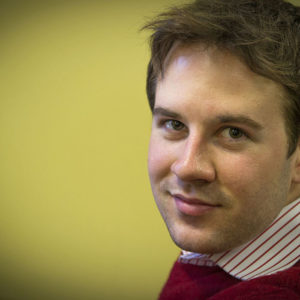Picture this. I’m standing at a podium in a meeting room at the headquarters of a Fortune 500 retail organization – presenting to one person. Yes, one individual who – by a generous estimate – was only half paying attention. His laptop occupied the other half, and the clacking of his keyboard echoed around the room as he continued to work and I continued awkwardly presenting to essentially nobody.
You’re probably wondering what in the world I was doing. Why was I presenting to a person who didn’t even seem to be interested in what I was saying? Let’s back up for a moment.
A Story About an Executive Who Was Missing the “Why”
A few days earlier, I had received a call from the Head of Learning and Development at a massive retail organization. He had been referred to us after seeing a dip in their customer experience scores. After an initial conversation, and knowing this is something we’ve had a lot of success with in the past, I agreed to meet at his headquarters to talk in more detail. A few days later, I woke up early, caught the first flight out, hopped in my rental car, and made it with time to spare.
Passionate about the topic at hand, I was energized for the conversation despite the fact that I had been up since 4 a.m. But my enthusiasm quickly ebbed when he greeted me in the lobby, saying, “I hope you don’t mind, but I’ve got some work to do this morning, so I’ll be multitasking.” Then, whatever excitement I had left was completely sapped when he walked me to the large lecture hall, gestured to the podium where I could plug in my laptop to present, and slunk into a seat at the back of the room. What I hoped would be a conversation had quickly devolved into a lecture – to nobody!
But alas, I presented and – to drown out the echoes of his keyboard – did so as loudly as I could. I acted as if I were in front of a standing-room-only audience. As I was presenting a case study about a similarly sized organization, where we helped drive the highest customer experience scores they have ever had, he suddenly exploded out of his seat and screamed, “Stop!”
Was this good? Was this bad? Was the case study resonating? Had I worn out my welcome? I wasn’t sure what to think as he slowly descended the steps in the room.
He asked, “Your company did this?” while emphatically gesturing at the screen, his face scrunched in awe like Jeff Goldblum in Jurassic Park seeing the dinosaurs for the first time.
I overcame my shock at his sudden interest and confirmed that we did, in fact, help this organization achieve historically high customer service scores.
“Wait here!” he said, his newfound energy bubbling over. “I’ve got to get my bosses in here. They need to see this!” he yelled before quite literally sprinting out of the room.
I had done it. I had finally reached him! My early morning flight was not in vain. He came back a few minutes later – sweaty, out of breath, and joined by his colleagues.
“Tell them… tell them… tell them what you just told me,” he panted, recovering his breath.
I went over the case study, once again detailing how we helped create the highest customer service scores ever at a similar organization. But as I was talking, he quickly interrupted.
“Not that part. Not that part!” he hurried me along.
I was a bit confused. If he didn’t want me to talk about that, then what the heck did he want me to talk about?
Could it be the part where we used a combination of customer service data, voice of the customer, and observation to gather insights and identify where we could make the most meaningful impact and ensure we taught the right behaviors to maximize return on time and cost invested? Nope.
The part where we used those customer insights to craft and align on a new customer experience strategy and culture with senior leadership? Nope, again.
Or maybe the part where we worked with leaders and managers to give them the framework and skills to coach their teams to success in the new environment? Nope – not that part of the story either.
Well, it must be the part where we deployed a new customer service strategy and culture to the entire organization so that it was embraced by every employee, and then rapidly provided training to over 75,000 people, driving the highest customer service scores in the history of the organization, all within one year?
And that would be another no!
“Which part?” I asked.
“This part!” he said, pointing at the screen.
I turned my head to see that he was pointing at one tiny graphic on the screen: a picture of an app on a mobile phone.
The Details Should Never Eclipse the Strategy
“You can make apps?” he asked in awe. While I smiled back at him and nodded my head in confirmation, all I really wanted to say was, “Are you serious? Who cares?”
While we did create and deploy an app, it was one small part of a much broader story. As I worked to compose myself and respond to the executive, I was surprised at just how blind he was to the big-picture strategy I was presenting. It suddenly became pretty clear why the organization was struggling with its customer experience – the leadership wasn’t thinking strategically at all.
Here’s what I mean:
- The Head of Learning and Development at a global retail organization called me because the brand’s customer experience scores were slipping, and they needed help.
- I walked him through a case study in which we partnered with a very similar organization and within a year had created the highest customer service scores ever!
- He then rushed out of the room to get his colleagues – because he saw a screenshot of an app.
Don’t get me wrong. I love apps as much as anybody. And yes, it’s incredibly important that we’re able to meet employees and customers where they are by leveraging the technology they’re using in their everyday lives. But he completely missed the point. He needed a strategic plan connected to the business’s goals to help raise customer experience scores (not a standalone app), and I was giving him the blueprint on how to do so. But he didn’t care about the results. He only cared about the proverbial bells and whistles.
And this is exactly the mistake so many L&D professionals make. We tend to get caught up in the what, but not the why.
In this case, the executive had completely forgotten why he had called me in – to help him improve his customer experience scores. Instead, he became focused only on one tool we used to do that. If I promised the CEO to help them achieve significantly higher customer experience scores, do you think the CEO would care whether or not we used phones or computers to do it? Of course not! If I told the CEO, “We did this using poster boards and markers,” they would say, “Here’s some poster boards and markers. Get started!”
Again, it’s important to leverage the technology available to meet people where they are. And yes, it’s important to make sure what we create works seamlessly with existing systems.
But the primary focus should be on solving the problem and helping the organization achieve its strategic goals!
So, fellow L&D professionals, next time you’re given an assignment or tasked with solving a problem, don’t forget the why behind it. And pretty soon, you may find that your conversations have been elevated to a much more strategic level, and your initiatives are a lot more successful.
Colby Fordham has worked with some of the world’s most respected organizations. He is passionate about and has seen the value in strategically connecting Learning and Development to strategy. You can reach him at Colby.Fordham@rootinc.com.









